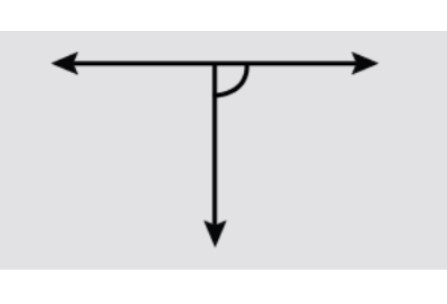
Classify the following angles as right, straight, acute, obtuse, or reflex.


Answer
511.2k+ views
Hint: Right angles are exclusively equal to $90{}^\circ $. Obtuse angles lie between $90{}^\circ $ and $180{}^\circ $. Acute angles lie between $0{}^\circ $ and $90{}^\circ $. Straight angles are exclusively equal to $180{}^\circ $. Reflex angles lie between $180{}^\circ $ and $360{}^\circ $.
Complete step-by-step answer:
Look at the figure closely. Since there is only one angle marked in the figure, we have to classify only that angle as right, straight, acute, obtuse, or straight.
Let’s start from backwards. Straight angle is an angle that is only equal to $180{}^\circ $. It can be thought of as the angle formed by a line, if we take any point on the line as the vertex of the angle. So, a straight angle is basically an angle where the vertex, and both the arms, lie on the same straight line. Over here, we can see that the vertex of the angle marked lies on the same line as both the arms, but the arms themselves are perpendicular to each other. Therefore, all the three don’t lie on the same straight line, and hence, the angle marked is not a straight angle.
Next, moving on to obtuse angles. Obtuse angles always lie between $90{}^\circ $ and $180{}^\circ $. The angle marked, can be seen is not more than $90{}^\circ $, hence, we can completely disregard the possibility of it being an obtuse angle.
Next, we have an acute angle. Acute angles lie between $0{}^\circ $ and $90{}^\circ $. We can also see from the figure, that the angle marked definitely is not smaller than $90{}^\circ $ either. So, it’s not an acute angle either.
Next, we have a reflex angle. A reflex angle lies between $180{}^\circ $ and $360{}^\circ $ always. We can also see that the angle marked does not look like the major sector of a circle. Hence, we can say that it’s not a reflex angle either.
However, till now, we have concluded that neither is it bigger than $90{}^\circ $, nor is it smaller than it. It, in fact, looks like it is exactly equal to $90{}^\circ $, and angles which are exclusively equal to $90{}^\circ $, are known as right angles.
Hence, we can conclude that the angle marked is a right angle.
Note: Don’t get confused between obtuse and reflex angle. To sum it up, if we consider any angle $x{}^\circ $, then it is acute when $0
Complete step-by-step answer:
Look at the figure closely. Since there is only one angle marked in the figure, we have to classify only that angle as right, straight, acute, obtuse, or straight.
Let’s start from backwards. Straight angle is an angle that is only equal to $180{}^\circ $. It can be thought of as the angle formed by a line, if we take any point on the line as the vertex of the angle. So, a straight angle is basically an angle where the vertex, and both the arms, lie on the same straight line. Over here, we can see that the vertex of the angle marked lies on the same line as both the arms, but the arms themselves are perpendicular to each other. Therefore, all the three don’t lie on the same straight line, and hence, the angle marked is not a straight angle.
Next, moving on to obtuse angles. Obtuse angles always lie between $90{}^\circ $ and $180{}^\circ $. The angle marked, can be seen is not more than $90{}^\circ $, hence, we can completely disregard the possibility of it being an obtuse angle.
Next, we have an acute angle. Acute angles lie between $0{}^\circ $ and $90{}^\circ $. We can also see from the figure, that the angle marked definitely is not smaller than $90{}^\circ $ either. So, it’s not an acute angle either.
Next, we have a reflex angle. A reflex angle lies between $180{}^\circ $ and $360{}^\circ $ always. We can also see that the angle marked does not look like the major sector of a circle. Hence, we can say that it’s not a reflex angle either.
However, till now, we have concluded that neither is it bigger than $90{}^\circ $, nor is it smaller than it. It, in fact, looks like it is exactly equal to $90{}^\circ $, and angles which are exclusively equal to $90{}^\circ $, are known as right angles.
Hence, we can conclude that the angle marked is a right angle.
Note: Don’t get confused between obtuse and reflex angle. To sum it up, if we consider any angle $x{}^\circ $, then it is acute when $0
Recently Updated Pages
Glucose when reduced with HI and red Phosphorus gives class 11 chemistry CBSE

The highest possible oxidation states of Uranium and class 11 chemistry CBSE

Find the value of x if the mode of the following data class 11 maths CBSE

Which of the following can be used in the Friedel Crafts class 11 chemistry CBSE

A sphere of mass 40 kg is attracted by a second sphere class 11 physics CBSE

Statement I Reactivity of aluminium decreases when class 11 chemistry CBSE

Trending doubts
Give 10 examples for herbs , shrubs , climbers , creepers

Write a letter to the editor of a newspaper on reckless class 6 english CBSE

The planet nearest to earth is A Mercury B Venus C class 6 social science CBSE

Number of Prime between 1 to 100 is class 6 maths CBSE

How many millions make a billion class 6 maths CBSE

How many time zones are in China class 6 social science CBSE




